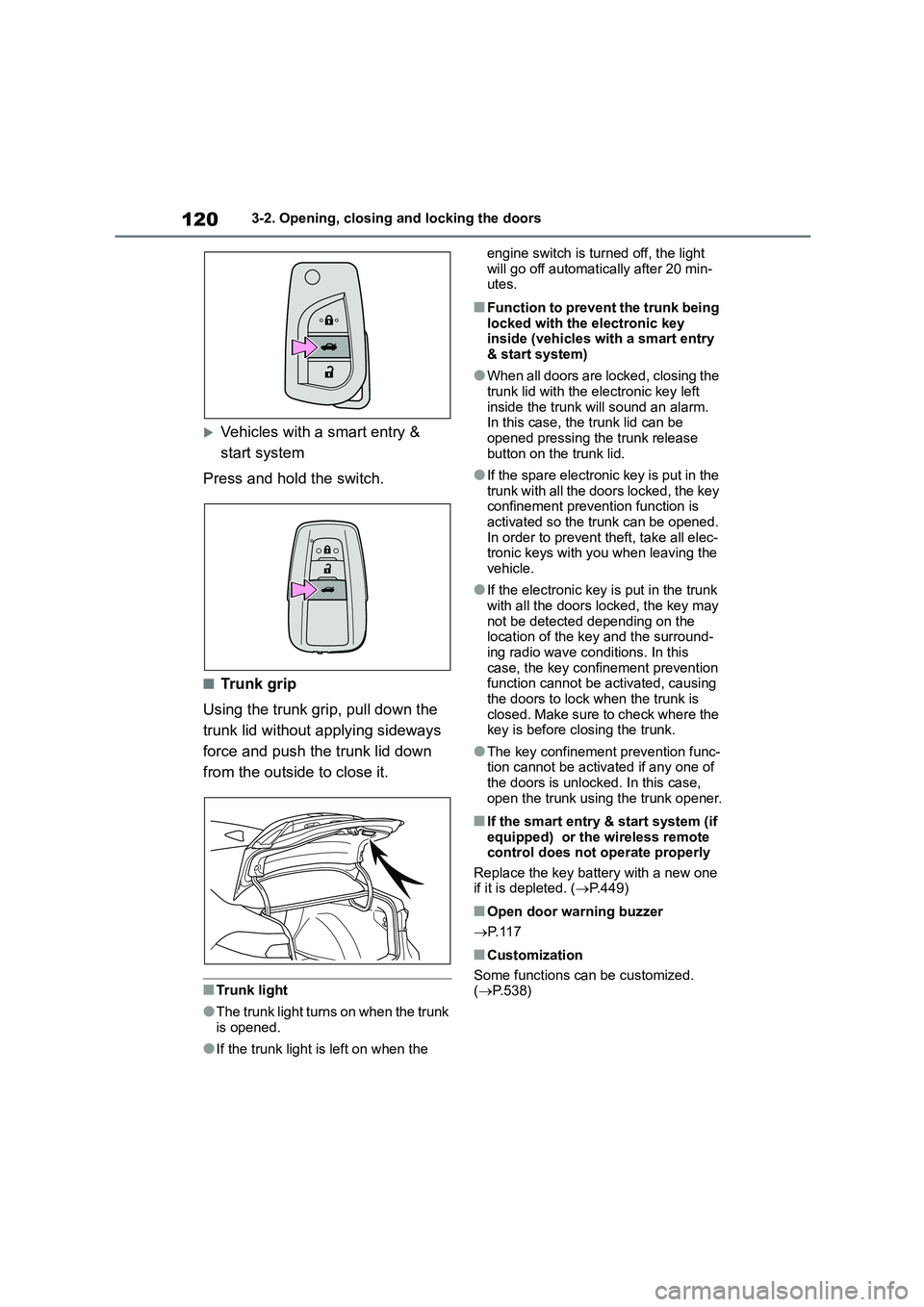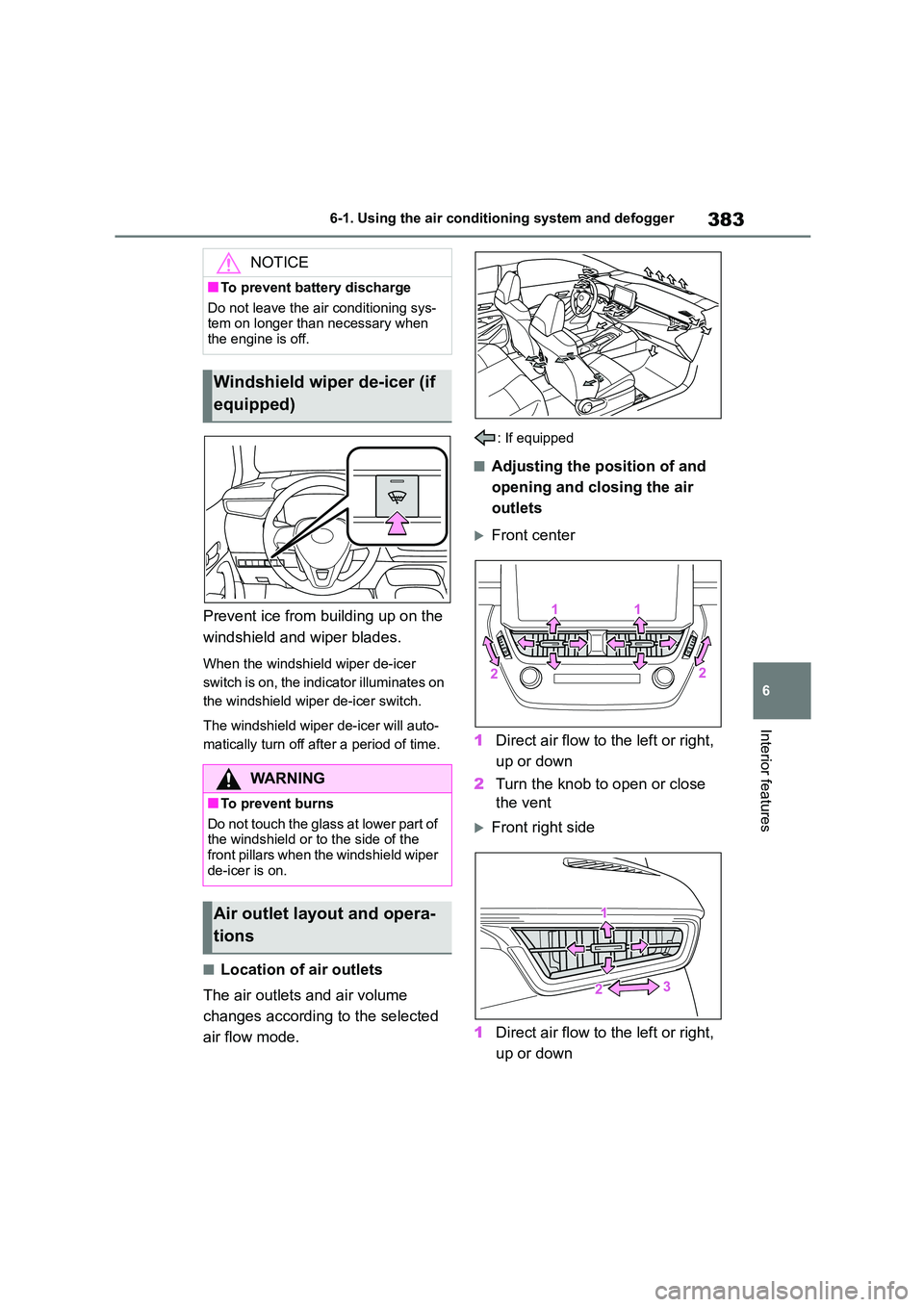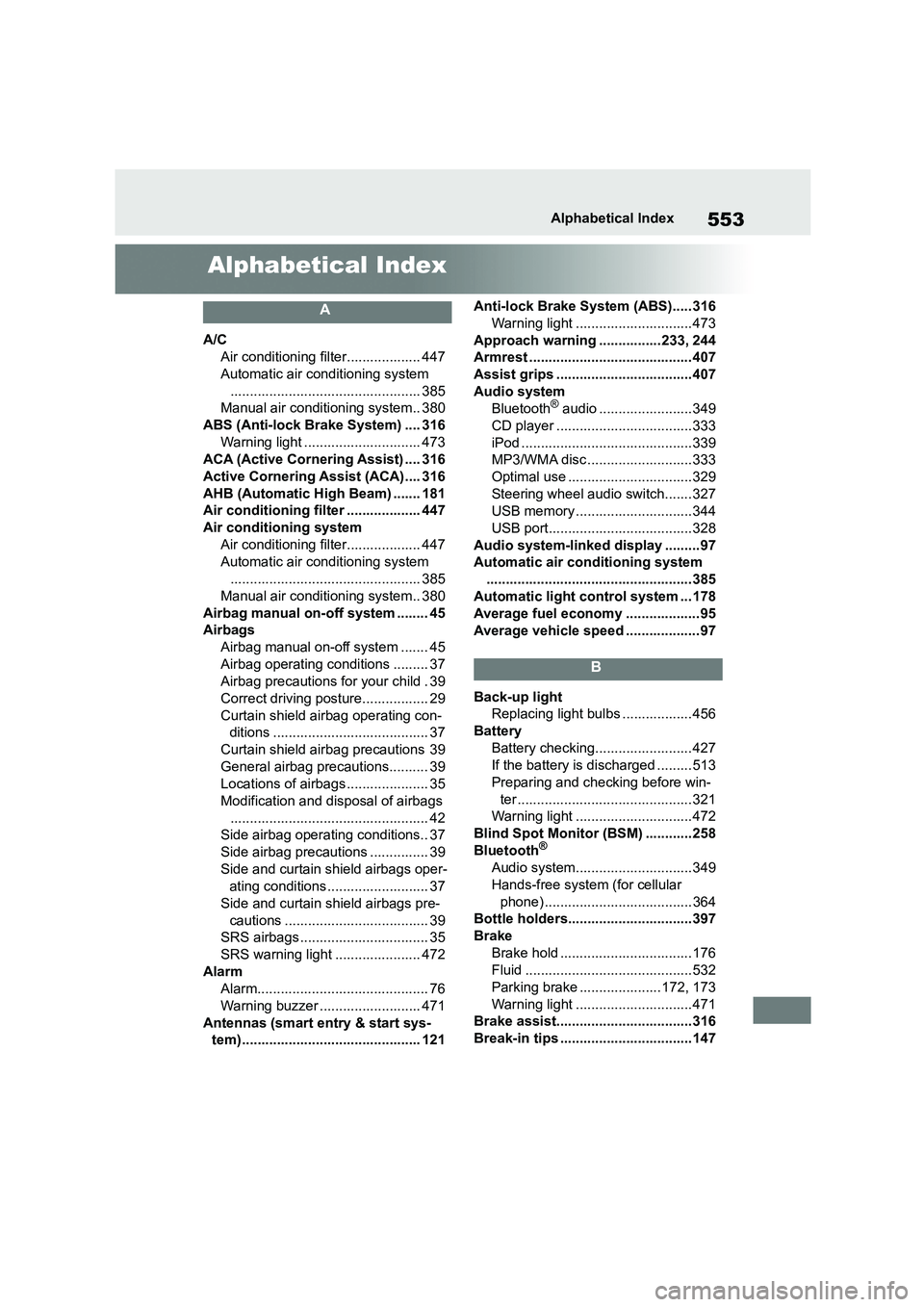2022 TOYOTA COROLLA battery location
[x] Cancel search: battery locationPage 122 of 678

1203-2. Opening, closing and locking the doors
Vehicles with a smart entry &
start system
Press and hold the switch.
■Trunk grip
Using the trunk grip, pull down the
trunk lid without applying sideways
force and push the trunk lid down
from the outside to close it.
■Trunk light
●The trunk light turns on when the trunk
is opened.
●If the trunk light is left on when the
engine switch is turned off, the light
will go off automatically after 20 min- utes.
■Function to prevent the trunk being
locked with the electronic key
inside (vehicles with a smart entry & start system)
●When all doors are locked, closing the trunk lid with the electronic key left
inside the trunk will sound an alarm.
In this case, the trunk lid can be opened pressing the trunk release
button on the trunk lid.
●If the spare electronic key is put in the
trunk with all the doors locked, the key
confinement prevention function is activated so the trunk can be opened.
In order to prevent theft, take all elec-
tronic keys with you when leaving the vehicle.
●If the electronic key is put in the trunk with all the doors locked, the key may
not be detected depending on the
location of the key and the surround- ing radio wave conditions. In this
case, the key confinement prevention
function cannot be activated, causing the doors to lock when the trunk is
closed. Make sure to check where the
key is before closing the trunk.
●The key confinement prevention func-
tion cannot be activated if any one of the doors is unlocked. In this case,
open the trunk using the trunk opener.
■If the smart entry & start system (if
equipped) or the wireless remote control does not operate properly
Replace the key battery with a new one
if it is depleted. ( P.449)
■Open door warning buzzer
P. 1 1 7
■Customization
Some functions can be customized.
( P.538)
Page 126 of 678

1243-2. Opening, closing and locking the doors
●Touching the door lock or unlock sen-
sor while wearing gloves may prevent lock or unlock operation.
●On some models: When the lock operation is performed using the lock
sensor, recognition signals will be
shown up to two consecutive times. After this, no recognition signals will
be given.
●If the door handle becomes wet while
the electronic key is within the effec-
tive range, the door may lock and unlock repeatedly. In that case, follow
the following correction procedures to
wash the vehicle: • Place the electronic key in a location 2
m (6 ft.) or more away from the vehi-
cle. (Take care to ensure that the key is not stolen.)
• Set the electronic key to battery-sav-
ing mode to disable the smart entry & start system. ( P.122)
●If the electronic key is inside the vehi- cle and a door handle becomes wet
during a car wash, a message may be
shown on the multi-information dis- play and a buzzer will sound outside
the vehicle. To turn off the alarm, lock
all the doors.
●The lock sensor may not work prop-
erly if it comes into contact with ice, snow, mud, etc. Clean the lock sensor
and attempt to operate it again.
●A sudden handle operation or a han-
dle operation immediately after enter-
ing the effective range may prevent the doors from being unlocked. Touch
the door unlock sensor and check that
the doors are unlocked before pulling the door handle again.
●If there is another electronic key in the
detection area, it may take slightly longer to unlock the doors after the
door handle is gripped.
■When the vehicle is not driven for
extended periods
●To prevent theft of the vehicle, do not
leave the electronic key within 2 m (6 ft.) of the vehicle.
●The smart entry & start system can be
deactivated in advance. ( P.538)
●Setting the electronic key to bat-
tery-saving mode helps to reduce key battery depletion. ( P.122)
■To operate the system properly
●Make sure to carry the electronic key when operating th e system. Do not
get the electronic key too close to the
vehicle when operating the system from the outside of the vehicle.
Depending on the position and holding condition of the electronic key, the key
may not be detected correctly and the
system may not operate properly. (The alarm may go off accidentally, or the
door lock prevention function may not
operate.)
●Do not leave the electronic key inside
the trunk. The key confinement prevention func-
tion may not operate, depending on
the location of the key (the inside edge of the trunk), conditions (inside a
metal bag, close to metallic objects)
and the radio waves in the surround- ing area. ( P.120)
■If the smart entry & start system
does not operate properly
●Locking and unlocking the doors
(vehicles with entry function): P.512
●Starting the engine: P.512
■Customization
Some functions can be customized.
( P.538)
■If the smart entry & start system has been deactivated in a custom-
ized setting
●Locking and unlocking the doors (vehicles with entry function): Use the
wireless remote control or mechanical
key. ( P.113, 512)
●Starting the engine and changing
engine switch modes: P.512
●Stopping the engine: P.162
Page 308 of 678

3064-5. Using the driving support systems
“Currently Unavailable”
There may be a system failure.
Power steering equipment is temporarily over-
heating.
Turn the engine switch off, wait for a little
while, and then start the engine again.
The engine is not operating.
Start the engine.
Ice, snow, dirt, etc., has adhered to a sensor.
Remove any ice, snow, dirt, etc.
Remove any ice, snow, dirt, etc.
The sensor is frozen.
Once the sensor thaws, the system will
return to normal.
The battery has been removed and reinstalled.
Drive the vehicle straight ahead for 5 sec-
onds or more at a speed of approximately
35 km/h (22 mph) or higher.
“Excessive Speed”
The S-IPA switch is operated when the vehicle
speed exceeds 30 km/h (16 mph).
Operate the switch when the vehicle
speed is approximately 30 km/h (16 mph)
or less.
“Unavailable”
“Try Another Location”
The S-IPA switch is operated in an area with no
parking spaces, or operated in an area where
the road width for parking is narrow.
Assist control cannot be used, as there is
no parking space. Proceed to a parking
space which width is approximately 2.6 m
(8.5 ft.) or larger.
Assist control cannot be used, as the
road width is narrow. Proceed to a park-
ing space where the road width is approx-
imately 4.5 m (15 ft.) or larger.
MessageSituation/Handling method
Page 385 of 678

383
6
6-1. Using the air conditioning system and defogger
Interior features
Prevent ice from building up on the
windshield and wiper blades.
When the windshield wiper de-icer
switch is on, the indicator illuminates on
the windshield wiper de-icer switch.
The windshield wiper de-icer will auto-
matically turn off after a period of time.
■Location of air outlets
The air outlets and air volume
changes according to the selected
air flow mode.
: If equipped
■Adjusting the position of and
opening and closing the air
outlets
Front center
1 Direct air flow to the left or right,
up or down
2 Turn the knob to open or close
the vent
Front right side
1 Direct air flow to the left or right,
up or down
NOTICE
■To prevent battery discharge
Do not leave the air conditioning sys-
tem on longer than necessary when the engine is off.
Windshield wiper de-icer (if
equipped)
WA R N I N G
■To prevent burns
Do not touch the glass at lower part of
the windshield or to the side of the
front pillars when the windshield wiper de-icer is on.
Air outlet layout and opera-
tions
Page 480 of 678

4788-2. Steps to take in an emergency
■Parking brake indicator
■Brake hold operated indicator
■Warning buzzer
In some cases, the buzzer may not be
heard due to being in a noisy location or audio sound.
■Front passenger detection sensor,
seat belt reminder and warning
buzzer
●If luggage is placed on the front pas-
senger seat, the front passenger detection sensor may cause the warn-
ing light to flash and the warning
buzzer to sound even if a passenger
is not sitting in the seat.
●If a cushion is placed on the seat, the
sensor may not detect a passenger, and the warning light may not operate
properly.
■If the malfunction indicator lamp
comes on while driving
The malfunction indicator lamp will
come on if the fuel tank becomes com-
pletely empty. If the fuel tank is empty, refuel the vehicle immediately. The mal-
function indicator lamp will go off after
several trips.
If the malfunction indicator lamp does
not go off, contact any authorized Toyota
retailer or Toyota authorized repairer, or any reliable repairer as soon as possi-
ble.
■Electric power steering system
warning light (warning buzzer)
When the battery charge becomes
insufficient or the voltage temporarily
drops, the electric power steering sys- tem warning light may come on and the
warning buzzer may sound.
■When the tire pressure warning
light comes on
Inspect the tires to check if a tire is
punctured.
If a tire is punctured: P.482, 498
If none of the tires are punctured:
Turn the engine switch off then turn it to
ON. Check if the tire pressure warning light comes on or blinks.
If the tire pressure warning light blinks
for approximately 1 minute then stays on
There may be a malfunction in the tire pressure warning system. Have the
vehicle inspected by any authorized
Toyota retailer or Toyota authorized repairer, or any reliable repairer immedi-
ately.
Warning lightDetails/Actions
(Flashes)
It is possible that the parking brake is not fully engaged or
released
Operate the parking brake once again.
This light comes on when the parking brake is not released. If the
light turns off after the parking brake is fully released, the system is
operating normally.
Warning lightDetails/Actions
(Flashes)
(if equipped)
Indicates a malfunction in the brake hold system
Have the vehicle inspected by any authorized Toyota
retailer or Toyota authorized repairer, or any reliable
repairer immediately.
Page 555 of 678

553Alphabetical Index
Alphabetical Index
A
A/C
Air conditioning filter................... 447
Automatic air conditioning system
................................................. 385
Manual air conditioning system.. 380
ABS (Anti-lock Brake System) .... 316
Warning light .............................. 473
ACA (Active Cornering Assist) .... 316
Active Cornering Assist (ACA).... 316
AHB (Automatic High Beam) ....... 181
Air conditioning filter ................... 447
Air conditioning system
Air conditioning filter................... 447
Automatic air conditioning system
................................................. 385
Manual air conditioning system.. 380
Airbag manual on-off system ........ 45
Airbags
Airbag manual on-off system ....... 45
Airbag operating conditions ......... 37
Airbag precautions for your child . 39
Correct driving posture................. 29
Curtain shield airbag operating con-
ditions ........................................ 37
Curtain shield airbag precautions 39
General airbag precautions.......... 39
Locations of airbags ..................... 35
Modification and disposal of airbags
................................................... 42
Side airbag operating conditions.. 37
Side airbag precautions ............... 39
Side and curtain shield airbags oper-
ating conditions .......................... 37
Side and curtain shield airbags pre-
cautions ..................................... 39
SRS airbags ................................. 35
SRS warning light ...................... 472
Alarm
Alarm............................................ 76
Warning buzzer .......................... 471
Antennas (smart entry & start sys-
tem).............................................. 121
Anti-lock Brake System (ABS)..... 316
Warning light ..............................473
Approach warning ................233, 244
Armrest .......................................... 407
Assist grips ...................................407
Audio system
Bluetooth® audio ........................349
CD player ...................................333
iPod ............................................339
MP3/WMA disc ...........................333
Optimal use ................................329
Steering wheel audio switch....... 327
USB memory ..............................344
USB port.....................................328
Audio system-linked display ......... 97
Automatic air conditioning system
..................................................... 385
Automatic light control system ... 178
Average fuel economy ................... 95
Average vehicle speed ................... 97
B
Back-up light
Replacing light bulbs ..................456
Battery
Battery checking......................... 427
If the battery is discharged ......... 513
Preparing and checking before win-
ter ............................................. 321
Warning light ..............................472
Blind Spot Monitor (BSM) ............258
Bluetooth®
Audio system..............................349
Hands-free system (for cellular
phone) ...................................... 364
Bottle holders................................397
Brake
Brake hold .................................. 176
Fluid ...........................................532
Parking brake .....................172, 173
Warning light ..............................471
Brake assist...................................316
Break-in tips .................................. 147